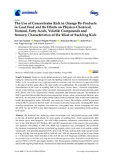Mostrar el registro sencillo del ítem
The use of concentrates rich in orange by-products in goat feed and its effects on physico-chemical, textural, fatty acids, volatile compounds and sensory characteristics of the meat of suckling kids
| dc.creator | Guzmán, José Luis | es_ES |
| dc.creator | Delgado Pertíñez, M. | es_ES |
| dc.creator | Beriain Apesteguía, María José | es_ES |
| dc.creator | Pino, Rafael | es_ES |
| dc.creator | Zarazaga, Luis Ángel | es_ES |
| dc.creator | Horcada, Alberto | es_ES |
| dc.date.accessioned | 2020-08-06T08:35:33Z | |
| dc.date.available | 2020-08-06T08:35:33Z | |
| dc.date.issued | 2020 | |
| dc.identifier.issn | 2076-2615 | |
| dc.identifier.uri | https://hdl.handle.net/2454/37752 | |
| dc.description.abstract | We analysed how replacing cereal concentrates with dehydrated orange pulp (DOP) in the diet of mother goats affects the meat quality of suckling kids. Three experimental diets for mother goats were designed. The DOP-0 diet contained commercial concentrates and alfalfa hay. In the DOP-40 and DOP-80 diets, 40% and 80% (respectively) of the cereal in the concentrate was replaced with pellets of DOP (the alfalfa hay component was unchanged). We evaluated the chemical composition, texture, water holding capacity, colour, fatty acids (FAs) profile, volatile compounds, and sensorial appraisal of the meat from 30 male suckling kids (cold carcass weight 4.74 kg, 4.82 kg, and 4.65 kg for DOP-0, DOP-40, and DOP-80, respectively) of the Payoya breed (n = 10 for each diet). Meat from kids in the DOP-40 and DOP-80 groups exhibited characteristics favourable for human health, including the meat’s thrombogenicity index, PUFA/SFA ratio (0.60 index), and n-6 PUFA/n-3 PUFA ratio (approximately 7.50). The meat also exhibited reduced MUFA content (around 460 mg/100 g fresh meat). An increase in ethyl furan, dimethyl disulphide and heptane was observed in grilled meat from goats that were fed using DOP. The inclusion of DOP in goat feed improved consumers’ sensory appreciation of the kid’s meat. | en |
| dc.description.sponsorship | This research was supported by a Regional Project funded by Excma. Diputación de Huelva, Spain. | en |
| dc.format.extent | 17 p. | |
| dc.format.mimetype | application/pdf | en |
| dc.language.iso | eng | en |
| dc.publisher | MDPI | en |
| dc.relation.ispartof | Animals, 2020, 10 (5), 766 | en |
| dc.rights | © 2020 by the authors. Licensee MDPI, Basel, Switzerland. This article is an open access article distributed under the terms and conditions of the Creative Commons Attribution (CC BY) license. | en |
| dc.rights.uri | http://creativecommons.org/licenses/by/4.0/ | |
| dc.subject | By-products | en |
| dc.subject | Feeding sources | en |
| dc.subject | Goats | en |
| dc.subject | Orange pulp | en |
| dc.title | The use of concentrates rich in orange by-products in goat feed and its effects on physico-chemical, textural, fatty acids, volatile compounds and sensory characteristics of the meat of suckling kids | en |
| dc.type | info:eu-repo/semantics/article | en |
| dc.type | Artículo / Artikulua | es |
| dc.contributor.department | Institute on Innovation and Sustainable Development in Food Chain - ISFOOD | es_ES |
| dc.rights.accessRights | info:eu-repo/semantics/openAccess | en |
| dc.rights.accessRights | Acceso abierto / Sarbide irekia | es |
| dc.identifier.doi | 10.3390/ani10050766 | |
| dc.relation.publisherversion | https://doi.org/10.3390/ani10050766 | |
| dc.type.version | info:eu-repo/semantics/publishedVersion | en |
| dc.type.version | Versión publicada / Argitaratu den bertsioa | es |



